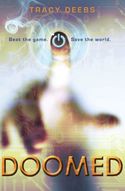
 Since DOOMED came out, I’ve been asked hundreds of times about why I chose to go the cyber route with the Pandora’s Box myth. So when I was trying to come up with a topic for this blogpost, I thought telling you a little about the book—and my motivation for it—might be the way to go.
Since DOOMED came out, I’ve been asked hundreds of times about why I chose to go the cyber route with the Pandora’s Box myth. So when I was trying to come up with a topic for this blogpost, I thought telling you a little about the book—and my motivation for it—might be the way to go.
I’ve always loved the Pandora myth and have always wanted to write a book from her point of view because I think she got a bad rap (as women tend to do in mythology). In the original Greek myth Zeus and Hephaestus mold Pandora from clay as a punishment to Prometheus for stealing fire from the gods — she was specifically created to bring trouble to him and to do exactly what she did, so I find it very hard to blame her for that. Prometheus, of course, knows Zeus is unhappy with him and knows he wouldn’t be sending him a gift without strings attached, so he refuses Pandora. He warns his brother, Epimetheus, to do the same, but Epimetheus is less of a planner and much more impetuous than Prometheus. He accepts Pandora in what is one of the first love triangles ever and the rest is history …
I wanted to bring those aspects of the story to DOOMED, so I created Pandora, Theo (Prometheus) and Eli (Epimetheus), as well as Pandora’s father who is directly responsible for the evil that Pandora unleashes. But I had originally planned to set the story in New Orleans and have her accidentally open a crypt in one of the cemeteries which would bring down a bunch of natural disasters, plagues, etc. Then, one day at the very beginning of the planning process, my agent asked this fateful question: “What if she opens an attachment instead of a box?” The idea caught my attention right away and in the next few weeks, I worked like a crazy woman putting together a synopsis for DOOMED that included a Stuxnet type worm that brings down civilization as we know it, an MMO called Pandora’s Box that starts it all, a countdown to nuclear annihilation (Fukishima, the Japanese power plant that had a meltdown was going on at this time, with its inability to deliver electricity that caused the leaks and just fit perfectly into the book), and a real-life scavenger hunt for Pandora to go on to try to stop the destruction of the world as we know it.
I didn’t want her to be alone, as the mythological Pandora wasn’t alone, so I created my own versions of the Titans Prometheus and Epimetheus to go along with her. Theo, like Prometheus, is wicked smart, talented, strong, a careful (sometimes too careful) planner and willing to sacrifice himself for the cause. Eli is a total charmer. He’s fun, exciting, impetuous (often too impetuous) and is the life of the party.
The world we live in is so technologically dependent that when I was writing the book, I realized that we were ripe for the retelling of this myth. In the course of my research, I talked to a LOT of engineers in numerous fields as well as numerous experts on Stuxnet (the worm created to attack the Iranian nuclear program) and it occurred to me just how precarious a place we are in. Before Stuxnet was created by the U.S. government there was a limit to what cyber-warfare was available. But after its inception, everything changed — at least according to every expert I’ve spoken to and every article I’ve read. While Stuxnet was originally designed with a self-destruct date and very narrow parameters of what systems it could attack — it still jumped outside of its original target. This led it to being mapped by leading experts in the field in various countries. Which then led to the creation of other Stuxet type worms by people who are less concerned with the chaos they wreak and who haven’t added in self-destruct dates and other failsafes. It sounds farfetched, but when Stuxnet was found — despite all the precautions to the contrary — inside the operating systems of Chevron, an American company, virus and malware experts the world over became even more concerned about just what the terrifying future of cyberwarfare is going to look like.
It is the horror of this possibility that I tried to capture with DOOMED. What would the world look like if everything stopped working — not just for a few days, but indefinitely, with no quick fix in sight? With no promise that things would do anything but get worse? All the research I did on epidemics and sociology predicted that it would take very little time for society to break down. But at the same time, I wanted there to be something that could be done to stop the destruction. Not necessarily fix the damage that was done, as there are no quick fixes in DOOMED, but to at least give Prometheus (Theo) a chance to steal that fire from the gods … or in the case of my story, the game matrix that can stop the destruction even if it can’t repair it.
So I guess what all this boils down to is I chose to go the Cyber route with my Pandora story because it just made sense to me in the world that I live in. In America today, plague and pestilence aren’t high on the list of things most of us worry about … and neither are Zombie and Vampire Apocalypses. But trying to live and work and survive in a world where it becomes impossible to access money or pump gas to run cars or generators or keep trucks running to deliver food or … the list of what will fail without Internet or communications or electricity seemed infinite when I was writing DOOMED and it was our helplessness in the face of this evil loosed by a modern day Pandora that I really wanted to explore.
Thanks so much for having me here today! And readers, leave a comment about your own favorite Greek myth and be entered to win a signed copy of DOOMED 🙂 Have a great week!
To comment on Tracy Deebs’s blog please click here.


No Comments
Comments are closed.